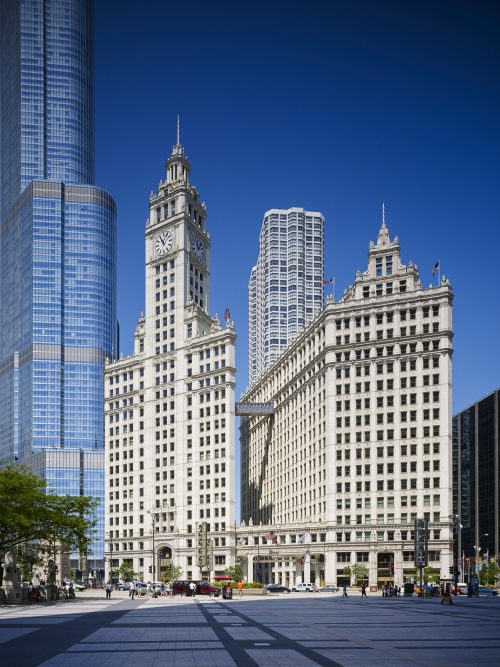By Megan McKinney
Within four months of producing the delightful Benjamin H. Marshall: Chicago Architect, John Zukowsky has surprised us with another important book devoted to Chicago’s spectacular architecture. His Building Chicago:The Architectural Masterworks, to be published by Rizzoli on October 11, provides another reason to love the city in which we live.
Building Chicago also follows Masterpieces of Chicago Architecture, the author’s 2003 collaboration with Martha Thorne, which highlighted the Art Institute of Chicago’s collection of architectural photography. However, as Mr. Zukowsky, former longtime Art Institute curator of architecture, points out in his introduction to the current volume, Building Chicago is “intended to be more than a sequel” to the previous book.
Instead, the 220 visuals in Building Chicago are from the Chicago History Museum’s collection of 1.5 million architectural images and include photographs from the museum’s magnificent Hedrich Blessing collection. Produced in association with the Chicago History Museum, the book’s foreword is by President Gary T. Johnson.
For those of us who are absorbed in both Chicago’s fascinating history and its astonishing architecture, the images — illustrating the volume’s two century span of Chicago history through its built environment — are reason enough to acquire the book.
The above image of the Wrigley Building, with the Trump Tower behind it, is a bright, sparkling reflection of today’s city. Yet Building Chicago also presents quite another view of the famous Chicago landmark in one of the sweeping vintage photographs that are a particular delight of this book.
A smoky late-1920s aerial shot of S. Michigan Avenue and the Chicago River features the1924 Wrigley Building and the handsome London Guarantee Building, which had been completed across the river a year earlier. However, the shot also reveals acres of unsightly infrastructure, which Upper Wacker Drive and Grant Park were soon to make obsolete, a reminder of how much we owe to the Burnham Plan and such men as Daniel Burnham, Edward Bennett and Charles Wacker.
Other images in the “sweeping” category include a spectacular 1901 panoramic shot of the Union Stock Yards which is almost overwhelming and sufficiently comprehesive to convince the viewer of the physical immensity of the infamous site of wholesale slaughter. While these and other photographs of their extent and vintage are not available for reproduction by reviewers, the following pictures offer a sample of some of the more contained visual experiences in store for readers of Building Chicago.
One of these is the above view of the light court at Daniel Burnham and John Wellborn Root’s The Rookery. The singular space was redesigned in 1905 by Frank Lloyd Wright.
Mies van der Rohe’s Crown Hall, which houses the Illinois Institute of Technology’s College of Architecture, is one of the great 20th century German architect’s spectacular mid-century designs, a body of work that extended the richness of the legend of Chicago architecture by decades.
John Zukowsky also provides impressive images such as this view of the University Club’s towering Cathedral Hall.
A spectacular expression of Art Deco design is the bank of elevators at One North LaSalle, designed in 1930 by Goettsch Partners, Inc. Vitzthum & Burns.
And, possibly the jewel of Chicago’s North Shore is the Georgian Colonial Revival house at 1315 N. Lake Road in Lake Forest, displayed in this magnificent image by aerial and architectural photographer John Hill. The sumptuous residence was built in 1930 for Mrs. Kersey Coates Reed, one of the two daughters of John G. Shedd, a Marshall Field president and founder of Shedd Aquarium. Mrs. Reed, who was widowed shortly before the house was finished, later became Mrs. Stanley Keith. Widely considered David Adler’s most important design, the house is also thought by Adler experts, including author Stephen Salny, to be the finest interior work of Adler’s sister, Frances Elkins.
© Building Chicago: The Architectural Masterworks by John Zukowsky, Rizzoli New York, 2016.
Author Photo:
Robert F. Carl















